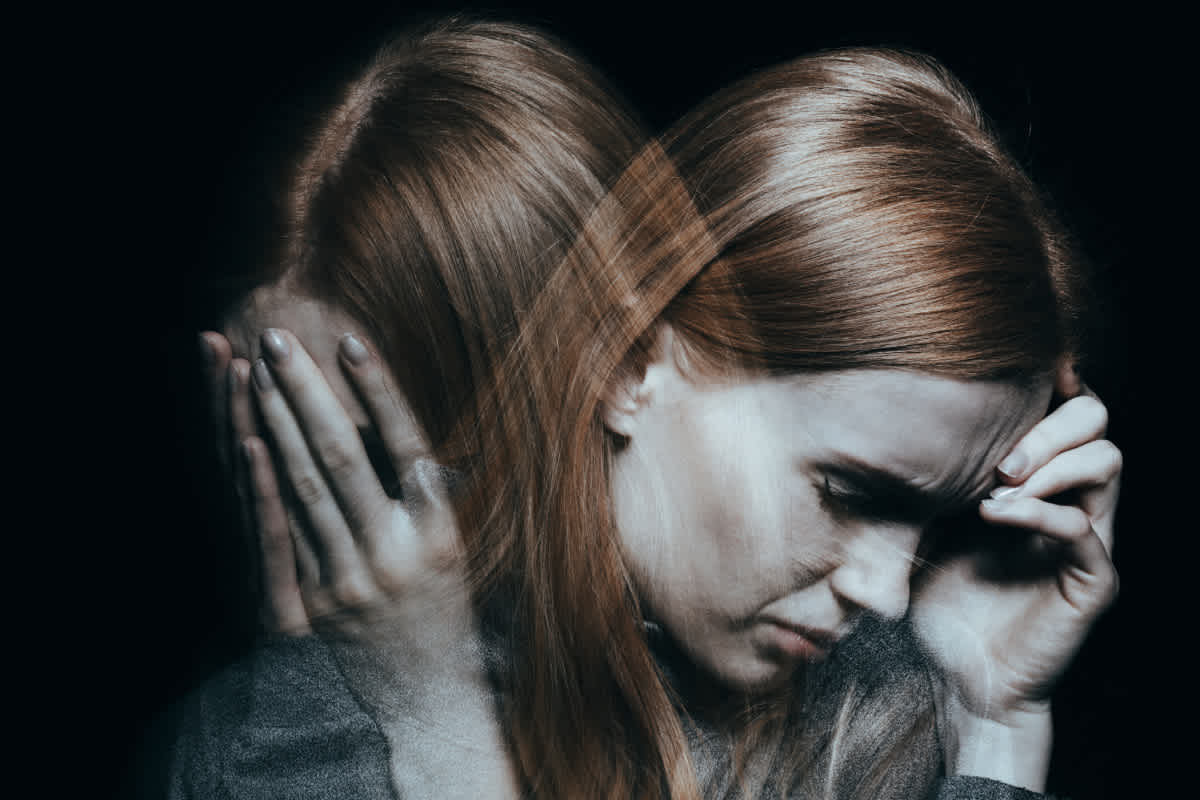Bipolar Disorder Guide

People who suffer from bipolar disorder experience extreme mood swings—from the intense highs of mania to the extreme lows of depression. The word "bipolar" refers to fluctuating between dramatic highs and lows.
Researchers estimate that 4.4% of U.S. adults experience bipolar disorder at some time in their lives. [1] For individuals struggling with this mental disorder—and for their loved ones and caretakers—this page provides vital information about bipolar disorder. The good news is that, with expert interventions, bipolar disorder can be effectively managed, allowing the people who experience it to live healthy and fulfilling lives.
Bipolar Disorder Self-Test
Your results of this self-assessment are not a replacement for a professional diagnosis, nor is this test meant to be a proper diagnostic tool. Please use it only for educational purposes and talk to your doctor about all your symptoms.
What Is Bipolar Disorder?
Bipolar disorder—previously known as manic-depressive illness or manic depression—is a serious mental illness associated with dramatic shifts in mood, concentration, energy and activity levels, and the capacity to function in daily life. It can be either chronic (persistent or constantly reoccurring) or episodic (occurring occasionally and at irregular intervals) and can be a genetic risk.
Everyone experiences normal emotional highs and lows: moments of feeling joyful or excited and others of feeling sad or discouraged. This is part of being human. But with bipolar disorder, the range of such mood changes is pathologically extreme.
An individual with a bipolar illness will experience periods of significantly elevated mood: excitement, overactivity, and feelings of euphoria. This is the manic part of the cycle. And they will experience other periods—the depressive part of the cycle—of feeling sad, hopeless, despondent, and indifferent. These mood disorder episodes can last for days, weeks, or months.
The onset of bipolar disorder is usually in late adolescence or early adulthood. [2] The disease can significantly affect the lives of those who suffer from it and their caregivers.
People with bipolar disorder may encounter work, school, and interpersonal relationship difficulties. They are prone to suicide attempts and are likely to have additional physical and psychiatric illnesses (known as comorbidity). They may also experience various side effects from medications prescribed to manage bipolar disorder.
Bipolar Disorder Symptoms
Psychiatrists and other mental health treatment professionals use the criteria described in the American Psychiatric Association's Diagnostic and Statistical Manual of Mental Disorders, Fifth Edition (DSM-5), to diagnose bipolar disorder. In the DSM-5, bipolar disorders are described as a group of disorders that cause extreme fluctuation in a person's mood, energy, and ability to function.
The specific symptoms of bipolar disorder will vary across individuals. What they all will have in common, however, are alternating mood episodes—some manic and others depressive. [3]
Symptoms of Manic Episodes
When a person has bipolar disorder and is having a manic episode, symptoms that may be present include [4]:
Feeling extremely happy, elated, or overjoyed
Feeling intensely touchy, irritable, jumpy, or wired
Being much more active than usual
Experiencing a decreased need for sleep or not being able to sleep
Being full of new and exciting ideas
Having racing thoughts: moving quickly from one idea to another
Talking very quickly
Feeling the ability to do many things at once without getting tired
Feeling unusually talented, important, or powerful
Feeling much better about oneself than is typical
Being easily distracted and unable to focus on one topic
Having an excessive appetite for food, alcohol, sex, or other pleasurable activities
Believing one can accomplish much more than they reasonably can
Making big decisions without thinking them through
Doing things that are out of character and perceived by others as risky, for instance, spending a lot of money, gambling, having casual sex with multiple partners, or using drugs or alcohol
The manic phase of bipolar disorder can last for weeks or months before it gives way to the depressive phase [5].
Symptoms of Depressive Episodes
When a person has bipolar disorder and is having a depressive episode, symptoms that may be present include [4] & [5]:
Feeling very down, sad, hopeless, or negative
Having less energy and feeling tired
Feeling slowed down
Feeling unable to do even simple things
Feeling pessimistic about everything
Feeling restless, irritable, or anxious
Having trouble concentrating or making decisions
Feeling worthless, empty, or hopeless
Having feelings of guilt and despair
Experiencing intense self-doubt
Talking very slowly or feeling unable to find anything to say
Being less interested in things one usually likes to do
Sleeping too much or not being able to sleep
Eating less than usual or over-eating
Losing or gaining weight, unintentionally
Having thoughts of death or suicide or attempting suicide
Similar to manic episodes, depressive episodes can last for weeks or months.
Some individuals with bipolar disorder may experience both manic and depressive symptoms in the same episode. This is known as an episode with mixed features. When a person experiences an episode with varied features, they can feel intensely sad or hopeless and extremely energized.
Psychotic Symptoms During a Manic or Depressive Episode
Occasionally, a person with bipolar disorder will have psychotic symptoms during a particularly severe manic or depressive episode. Such symptoms of psychosis can include:
Hallucinations—the person hears, sees, or feels things that are not actually there.
Delusions—the person experiences disturbed and illogical thinking, believing things that are not true.
A person experiencing a manic episode, for instance, may exhibit the psychotic symptom of believing that they have special powers or that they are being monitored by beings from outer space. A person experiencing a depressive episode may feel intensely guilty about something that they (incorrectly) believe they have done; or may feel that they don't actually exist.
Types of Bipolar Disorders
There are three types of bipolar disorder described in the DSM-5: bipolar I, bipolar II, and cyclothymic disorder. [6] All three types involve clear and dramatic mood, energy, and activity modulations. Someone who has bipolar disorder—regardless of the type—will cycle between being extremely energized or elated to feeling intensely sad, indifferent, or hopeless.
1. Bipolar I Disorder
The first type of bipolar disorder (bipolar I) is characterized by manic episodes that last at least seven days or are so severe that the individual requires hospitalization. In this type, depressive episodes last at least two weeks.
2. Bipolar II Disorder
The second type of bipolar disorder (bipolar II) is also characterized by a cycling of depressive episodes and hypomanic (a milder version of mania) episodes. However, the manic episodes are less severe than those in bipolar I disorder.
3. Cyclothymic Disorder
The third type of bipolar disorder (cyclothymia) is the mildest form of this disease. It is characterized by recurrent hypomanic and depressive symptoms (i.e., mood swings) that are not intense or long-lasting enough to qualify as hypomanic or depressive episodes.
Occasionally an individual may experience symptoms of bipolar disorder that do not fit into any of these three categories. In such cases, their condition is referred to (in the DSM-5) as "other specified and unspecified bipolar and related disorders."
Patterns of Depression and Mania
Among individuals diagnosed with bipolar disorder, there is variation in the timing and regularity of the manic and depressive episodes. Some people experience more depressive than manic episodes and vice versa.
Between episodes of depression and mania, a person may have periods where they experience a relatively normal mood.
Specific patterns that people with bipolar disorder may experience include:
Bipolar I or II with rapid cycling. In this pattern, the manic and depressive episodes swing quickly from one phase to another. Four or more mania episodes or depression within a year is considered rapid cycling.
Bipolar disorder with mixed state/features. In this pattern, manic and depressive symptoms occur at the same time. For instance, a person may experience a depressed mood while at the same time being overactive.
Bipolar I or II with a seasonal pattern. In this pattern, the depressive and manic/hypomanic episodes are affected by the change of seasons. For instance, a person may regularly experience a depressive episode during the winter; or a manic episode in the spring or fall.
Risk Factors for Bipolar Disorder
Experts don't know for sure what causes bipolar disorder. However, physiological, genetic, and environmental factors can all play a role in developing this mental disorder.
Brain Structure and Function
Researchers have discovered that the structure and function of the brain's prefrontal cortex may differ in patients with bipolar disorder. [7] These results suggest that abnormalities in brain structure and function may play a role in the appearance of bipolar disorder. This kind of research will hopefully support the development of more successful treatments.
Genetics
Is Bipolar disorder genetic? Bipolar disorder often runs in families, and there is strong evidence that people who have a parent or sibling with bipolar disorder are at increased risk of developing the genetic variant themselves. [8] However, studies of identical twins have discovered that one twin can develop bipolar disorder while the other does not. This shows that genes alone do not predetermine the development of bipolar disorder. [9]
Environmental Factors/Triggers
For some individuals, symptoms of bipolar disorder may be triggered by a stressful event or challenging circumstances such as [10]:
Physical, sexual, or emotional abuse
The death of a loved one
The breakup of a relationship
Physical illness or injury
Losing one's job
Sleep disturbances
Financial hardship
The environment can affect these brain functions. These regions develop in childhood, meaning upbringing has a vast impact. Environmental factors are vital to understanding personality disorders causes as well as brain function.
Treatments for Bipolar Disorder
Although symptoms of the bipolar disorder come and go, the disease typically requires lifelong treatment. It doesn't go away on its own.
Between episodes, an individual may be completely free from dramatic mood changes. Other people may experience lingering symptoms. In either case, long-term, continuous treatment can help people manage symptoms of bipolar disorder.
The overall goal of treatment for bipolar disorder is to reduce the number and severity of manic and depressive episodes and to allow the individual to live as everyday life as possible.
The good news is that skillful medical and psychiatric interventions, along with intelligent lifestyle choices, can enhance functioning and support an improved quality of life. A treatment plan featuring psychotherapy, medications, patient education, and robust support systems make bipolar disorders treatable [11].
Medications
Several medications can help prevent or reduce the severity of episodes of mania and depression. The prescribed medications will depend upon the patient's unique circumstances. These medicines include:
Mood stabilizers such as lithium and valproate
Antidepressants
Anticonvulsant medications
Antipsychotic medications
Benzodiazepine medications
Psychotherapy
Psychotherapy and counseling can be essential components of the treatment plan for people diagnosed with bipolar disorder. Mental health professionals help individuals identify and transform complex thoughts, emotions, and behaviors. Various forms of therapy can provide support, education, and guidance to people who have bipolar disorder.
Cognitive-behavioral therapy (CBT) can be an effective treatment for depression as well as insomnia—making it especially useful in the treatment of bipolar depression. Off-shoots of CBT include dialectical behavior therapy (DBT), acceptance and commitment therapy (ACT), and mindfulness-based cognitive therapy.
Mindfulness-based cognitive therapy (MBCT) has an excellent track record in helping resolve anxiety and depression—making it an ideal option for people who have bipolar disorder. [12]
Lifestyle
Eating well, exercising regularly, getting adequate sleep, spending time in nature, and planning healthy activities that one enjoys can help reduce the symptoms of bipolar disorder.
One of the common side effects of medications for bipolar disorder is weight gain. A healthy diet and regular exercise can limit this.
Avoiding alcohol and illegal drugs is another vital component of recovery from manic-depressive mood swings. Intelligent abstinence from these substances supports mental and physical stability.
Meditation, yoga, tai-chi, qigong, and Feldenkrais are holistic practices that can calm and harmonize the nervous system and help the person who has bipolar disorder to be less emotionally reactive.
Other Treatment Options
Some people may find these less conventional treatments to be helpful in managing bipolar symptoms:
Electroconvulsive therapy (ECT)—a procedure (administered under general anesthesia) in which small electric currents are passed through the brain to intentionally trigger a brief seizure. This transforms brain chemistry and, in some instances, can reverse symptoms of bipolar disorder and other mental health conditions. ECT is typically considered only when other treatment modalities have not been successful. [13]
Transcranial magnetic stimulation (TMS)—a noninvasive procedure that uses magnetic fields (rather than ECT's electrical currents) to stimulate nerve cells in the brain to improve symptoms of depression. Like ECT, TMS is generally used only when other modalities haven't been effective. [13]
Light therapy is one of the most effective evidence-based treatments for seasonal affective disorder. Many people with bipolar disorder experience worsening their depressive symptoms in winter—sometimes to the point of being diagnosed with SAD.
Find Professional Bipolar Disorder Treatment
If you or a loved one are suffering from bipolar disorder, help is available. Use our comprehensive treatment directory to find qualified mental health professionals who specialize in bipolar disorder treatment. Our directory includes providers offering various levels of care, from outpatient treatment and intensive outpatient programs to residential care when needed.
Mental health professionals in our network utilize proven therapeutic modalities such as:
Whether you're looking for specialized care for adults, teens, men, women, or other specific populations, our directory can help you find providers who match your unique needs and accept your insurance coverage.
Chronic mental illness can often create significant impairments and an inability to feel confident and successful in daily life. Mental health affects friends and family members just as much as the person who is struggling. Don't wait to seek help—explore our treatment directory today to find the right support for your bipolar disorder recovery journey.
References & Resources
Bipolar Disorder Statistics. National Institute of Mental Health. https://www.nimh.nih.gov/health/statistics/bipolar-disorder#:~:text=Prevalence%20of%20Bipolar%20Disorder%20Among%20Adults,-Based%20on%20diagnostic&text=An%20estimated%204.4%25%20of%20U.S.,some%20time%20in%20their%20lives.
Shah N, Grover S, Rao GP. Clinical Practice Guidelines for Management of Bipolar Disorder. Indian J Psychiatry. 2017 Jan;59(Suppl 1):S51-S66. https://www.ncbi.nlm.nih.gov/pmc/articles/PMC5310104/
Bipolar Disorder. National Institute of Mental Health. https://www.nimh.nih.gov/health/publications/bipolar-disorder
Bipolar Disorder. Rethink Mental Illness. https://www.rethink.org/advice-and-information/about-mental-illness/learn-more-about-conditions/bipolar-disorder/
Symptoms of Bipolar Disorder. National Health Service (UK). https://www.nhs.uk/mental-health/conditions/bipolar-disorder/symptoms/
Bipolar Disorder. National Institute of Mental Health. https://www.nimh.nih.gov/health/topics/bipolar-disorder
Clark L, Sahakian BJ. Cognitive neuroscience and brain imaging in bipolar disorder. Dialogues Clin Neurosci. 2008;10(2):153-63. https://www.ncbi.nlm.nih.gov/pmc/articles/PMC3181872/
Eisenstadt, Leah. Researchers find first strong genetic risk factor for bipolar disorder. Broad Institute News, April 6, 2022. https://www.broadinstitute.org/news/researchers-find-first-strong-genetic-risk-factor-bipolar-disorder
Gustafson C. Bruce Lipton, PhD: The Jump From Cell Culture to Consciousness. Integr Med (Encinitas). 2017 Dec;16(6):44-50. https://www.ncbi.nlm.nih.gov/pmc/articles/PMC6438088/
Causes of Bipolar Disorder. National Health Service (UK). https://www.nhs.uk/mental-health/conditions/bipolar-disorder/causes/
Treatment of Bipolar Disorder. National Health Service (UK). https://www.nhs.uk/mental-health/conditions/bipolar-disorder/treatment/
Hofmann SG, Gómez AF. Mindfulness-Based Interventions for Anxiety and Depression. Psychiatr Clin North Am. 2017 Dec;40(4):739-749. https://www.ncbi.nlm.nih.gov/pmc/articles/PMC5679245/
Brain Stimulation Therapies. National Institute of Mental Health. https://www.nimh.nih.gov/health/topics/brain-stimulation-therapies/brain-stimulation-therapies
Locate Treatment Centers Near You
Enter your location to discover facilities offering the care and support you need in your area.


